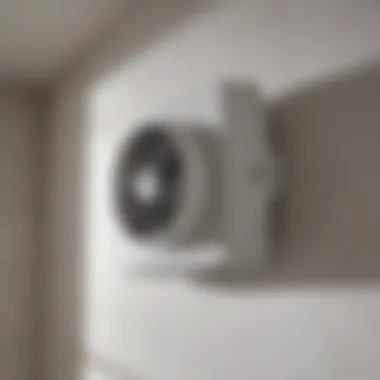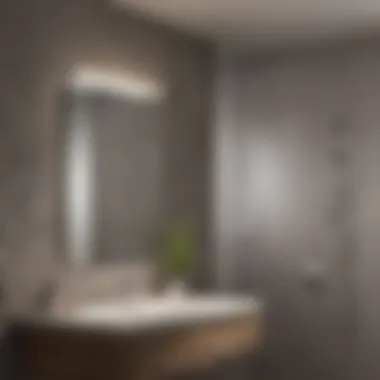The Essential Role of Bathroom Exhaust for Air Quality


Intro
Bathrooms are unique sanctuaries within our homes—places where we seek tranquility and personal care. Yet, for many, they're also breeding grounds for excess moisture, pungent odors, and mold. That’s where bathroom exhaust systems come into play. They serve a dual purpose: removing humid air and improving air quality. If well-maintained, these systems not only enhance the comfort but also the safety of these intimate spaces.
In this article, we'll dive into the various nuances of bathroom exhaust systems, from types of exhaust fans and their installation guidelines to the importance of regular maintenance and the risks posed by poor ventilation. Understanding these key elements is essential for homeowners and renters alike, ensuring that your bathroom remains a fresh and inviting retreat.
Trending Styles
When creating an inviting bathroom atmosphere, incorporating modern design styles can elevate both aesthetics and functionality.
Modern Minimalism
The modern minimalist approach champions clean lines, open spaces, and a clutter-free environment. Exhaust fans designed with sleek finishes can blend seamlessly into this decor, ensuring that functionality doesn’t clash with style. Think of streamlined models that operate quietly while efficiently extracting moist air. This understated elegance not only captivates but also ensures optimal performance without being obtrusive.
Cozy Rustic
On the flip side, a cozy rustic style may incorporate earthy tones and natural materials. A barn-style bathroom exhaust fan can add an interesting focal point while fulfilling its essential role. Imagine wood accents complemented by a fan that evokes a barn's charm, all while tirelessly working to keep humidity in check. This juxtaposition of style and necessity can create a space that feels as welcoming as a warm hug.
Color Palettes
The color choices in a bathroom layout can significantly influence the overall vibe and perception of cleanliness.
Calming Neutrals
Neutral tones such as soft whites, gentle grays, or light beiges provide a serene backdrop. These colors reflect light effectively and foster an airy ambiance that complements a well-functioning exhaust system’s purpose. The integration of neutral shades can further enhance the perception of freshness in the air.
Bold Accents
For those inclined towards a bit more flair, bold accents like deep blues or vibrant greens can invigorate a bathroom's atmosphere while keeping things lively. Such colors can draw attention to your exhaust fans, making them not just functional elements, but design features that enhance the room's character. This creates a balance where glam meets practicality, without overshadowing the primary role of promoting fresh air.
"Proper ventilation is essential; without it, your space can feel more like a swamp than a sanctuary."
By blending these trending styles and color palettes, homeowners can create bathrooms that are not only visually pleasing but also equipped for effective moisture control.
Understanding Bathroom Exhaust Systems
Bathroom exhaust systems play a pivotal role in maintaining a healthy indoor environment in both residential and commercial settings. The significance of these systems cannot be overstated, as they are primarily responsible for regulating moisture and ensuring that unpleasant odors do not linger in the air. In a space such as the bathroom, where steam from showers and baths can quickly accumulate, having an efficient exhaust system is crucial to avoid issues like mold growth and structural damage.
There are several key benefits associated with understanding bathroom exhaust systems. First and foremost, a well-functioning exhaust fan helps to eliminate not only moisture but also airborne contaminants such as volatile organic compounds (VOCs) that may be emitted from cleaning agents, toiletries, and other bathroom materials. This means improved air quality for anyone using the space.
Additionally, understanding how these systems operate can prevent potential health concerns. Without adequate ventilation, your bathroom could become a breeding ground for mold and mildew, which poses risks especially to those with respiratory issues.
Definition and Purpose
At its core, a bathroom exhaust system is designed to remove humid air from the bathroom and bring in cooler, drier air from outside or from adjacent spaces. This is crucial for preventing the moisture levels from rising too high. Humidity can cause a host of problems, including warped wood, stained paint, or even more severe structural issues over time. The purpose of an exhaust fan isn't just to circulate air; it's about creating a healthier and more pleasant environment.
A typical bathroom exhaust fan is activated either manually through a switch or automatically via a humidity sensor. This functionality allows the system to operate only when necessary, thus reducing energy consumption while still ensuring adequate moisture control and air quality.
How Exhaust Systems Work
The mechanics behind bathroom exhaust systems are relatively straightforward, yet effective. When the fan is turned on, it generates airflow that pulls humid, stale air out of the bathroom and pushes it through ductwork that typically leads to the outside of the building. This process is essential as it ushers in fresh air to take the place of the expelled moist air.
- Airflow Mechanics:
- Ducts and Venting:
- The fan motor powers the blades, creating suction that draws air in.
- This expelled air needs an exit route—ideally, a duct that leads outside rather than just into an attic or crawlspace, where it can still cause damage.
- The ducts must be properly sized and installed to ensure that air can move freely. When designing these systems, factors like duct size and length must be considered.
- Louvers or vent covers are placed at the termination point to prevent backdrafts, ensuring that outside air does not enter the ductwork when the fan is off.
In essence, the operational efficiency and placement of an exhaust fan can greatly influence its ability to manage air quality and moisture. Homeowners and renters alike must consider the design and installation of these systems to reap the full range of benefits.
Types of Bathroom Exhaust Fans
Understanding the different types of bathroom exhaust fans is crucial for selecting an appropriate solution for maintaining optimal air quality and moisture control in your home. Each type serves its purpose while offering unique benefits that can cater to the specific needs of your bathroom space. In this section, we will delve into three popular varieties: ceiling-mounted, wall-mounted, and inline fans.
Ceiling-Mounted Fans
Ceiling-mounted fans are perhaps the most recognizable type of exhaust fan found in bathrooms. Installed directly into the ceiling, these fans are typically discreet and blend seamlessly with the room's architecture. Beyond mere aesthetics, they offer several practical benefits.
- Effective Ventilation: Positioned at the highest point, ceiling-mounted fans efficiently expel warm, humid air that tends to rise after hot showers or baths.
- Space-Saving Design: Since these fans fit flush against the ceiling, they don't take up any wall space, making them ideal for smaller bathrooms where every inch counts.
- Varied Airflow Options: Many ceiling-mounted fans come with multiple speed settings, allowing homeowners to adjust airflow based on the level of humidity or personal preference.
However, the installation of ceiling-mounted fans does require some consideration. Proper positioning to connect to an external vent is essential for maximizing efficiency. Additionally, the ceiling's structure and type of lighting in the area can influence the choice and installation of the fan.
Wall-Mounted Fans
As the name implies, wall-mounted fans are fixed to the wall, usually at a height that aids in effective air extraction. These fans typically shine in larger bathrooms or spaces where ceiling installations aren’t feasible.
- Focused Airflow: Wall-mounted fans can be aimed to target specific areas, ensuring that damp air is effectively pulled away.
- Ease of Access: They are generally easier to reach for maintenance or cleaning purposes, which is a significant advantage for those who want to keep their bathroom in top shape.
- Versatility: Available in various designs and sizes, these fans can suit various styles of bathroom decor, making it easy to incorporate them without compromising on visual appeal.
On the flip side, wall-mounted fans can sometimes be noisier than their ceiling-mounted counterparts. Selecting a model known for quieter operation could be essential if sound is a concern.


Inline Fans
Inline fans are a more unconventional option that operates differently from ceiling or wall-mounted units. Instead of being visible in the bathroom, these fans are installed in the ductwork, often positioned in the attic or another hidden area.
This design offers a few noteworthy advantages:
- Noise Reduction: Since the fan is physically removed from the living space, inline fans are typically quieter, which can enhance the peace of your home environment.
- Efficiency: By being placed in the duct system, they can effectively service multiple bathroom areas, making them suitable for larger homes or those with multiple bathrooms on the same ventilation circuit.
- Design Flexibility: Given their hidden nature, inline fans won’t detract from the room's decor or layout.
Nevertheless, inline fans require careful planning in terms of ductwork and airflow calculations. They might be a bit more complicated to install, often needing professional intervention to ensure everything is properly connected and functioning at optimal performance.
As you consider which type of bathroom exhaust fan is best for your space, think about factors like room size, desired aesthetics, and specific airflow needs. Choosing the right exhaust fan can significantly enhance your bathroom experience by keeping fresh air circulating and moisture levels in check.
Benefits of Proper Exhaust Ventilation
Effective ventilation in bathrooms is not just a luxury; it's an essential part of maintaining a healthy home environment. Proper exhaust ventilation ensures that stale, humid air is expelled and replaced with fresh air. This process plays a pivotal role in preventing various issues that can arise in enclosed spaces, particularly in areas that experience significant moisture buildup such as bathrooms.
Moisture Control
Moisture control is arguably the most significant benefit of having a well-functioning bathroom exhaust system. Bathrooms are prone to high humidity levels, especially after a hot shower or bath. If moist air is left to linger, it can lead to problems like peeling paint, warped wood, and compromised building materials.
When a fan is installed correctly, it removes excess moisture before it settles in the corners. This not only helps maintain the aesthetic appeal of your bathroom but also ensures that your home’s structure remains secure over time. A typical bathroom fan can effectively reduce humidity levels by expelling moist air out of the home, promoting a healthier environment.
Mold and Mildew Prevention
Speaking of a healthy environment, another noteworthy advantage of bathroom exhaust systems is their role in mold and mildew prevention.
Did you know? Mold can start growing on surfaces that remain damp for as little as 24 to 48 hours?
This is why timely moisture removal is crucial. Mold spores thrive in dampness and warmth—exactly what your bathroom provides without proper ventilation. By incorporating an exhaust fan, you effectively cut off the mold's preferred habitat.
Installing a reliable fan can significantly reduce the likelihood of mold growing on tiles and around sinks. Utilizing this technology not only promotes a safer home for all inhabitants, particularly for those with respiratory issues, but also spares you unnecessary costs associated with mold remediation down the line.
Improved Indoor Air Quality
Lastly, let’s not overlook the improvement in indoor air quality that proper ventilation facilitates. Bathrooms can trap unpleasant odors, resulting in a stale atmosphere that can follow you out of the room. Adequate ventilation gets rid of these odors, contributing to an overall pleasant environment throughout the house.
Fresh air leads to a healthier living space, which is particularly important for families with sensitive members. Improved air quality can reduce the instances of headaches, fatigue, and in some cases, respiratory difficulties that can arise from lingering stale air and airborne pollutants.
In summary, proper exhaust ventilation in bathrooms is far from trivial. It offers vital benefits like moisture control, mold prevention, and enhanced air quality, which can ultimately lead to a more comfortable and healthier living space. Investing a bit in this area pays significant dividends, ensuring your home remains a sanctuary for you and your loved ones.
Installation Considerations
When it comes to bathroom exhaust systems, installation is a pivotal factor that can significantly impact their efficiency and functionality. Proper installation not only ensures a smooth operation but also maximizes the benefits of improving air quality and controlling moisture in the bathroom. Let's delve into some critical aspects to consider when installing these systems.
Selecting the Right Location
Choosing the ideal spot for your exhaust fan might seem straightforward, but it carries weighty implications. The location affects how well the system works in ventilating the space. A common practice is to install the fan near the shower or tub, where moisture tends to congregate the most.
Additionally, positioning it away from doors and windows can prevent incoming drafts from counteracting the fan’s effectiveness. Consider the layout of your bathroom; if it's a long or narrow space, placing the fan centrally might also assist in efficient air circulation.
Placement high up on the wall or ceiling is often recommended as moisture and heat rise. This allows the exhaust to capture humid air before it settles, optimizing the system’s performance. A little thought in this initial phase can save headaches down the lane.
Electrical Wiring Requirements
Understanding the electrical requirements of your exhaust fan is crucial for safe and effective operation. Each fan comes with specific wiring needs, so it's wise to consult the manufacturer's guidelines. You’ll likely need a dedicated circuit to avoid overloading existing electrical systems, which could lead to intermittent issues down the road.
Some fans even have light features, which may necessitate additional wiring. If you're not comfortable with electrical work, hiring a professional electrician is a smart move. They can ensure compliance with local building codes and safety regulations. Plus, it mitigates the risks of potential hazards that come with mismanaged wiring.
Ducting Options
Next comes the matter of ducting, which plays a huge role in how well your system actually operates. Many homeowners underestimate the significance of choosing the right duct type or size. Generally, a straight and short duct run will allow for better airflow. So, if you have the option, aim for as few bends and turns as possible in the duct path.
Types of ducts can vary; you might encounter rigid, semi-rigid, and flexible options. Rigid ducts tend to offer less resistance and maintain airflow efficiency better than flexible ones. However, flexible ducts can be easier to install in tight spaces. Opting for the correct diameter is also vital—too small, and the fan could be overworked; too large, and it might lead to poor performance. Always keep those factors in mind when planning your installation.
"Well-planned installation of your bathroom exhaust system is the first step towards a healthier indoor environment."
By paying close attention to these installation considerations, you'll lay a solid foundation for effective moisture control and air quality improvement in your bathroom. Each detail—from location choices to proper wiring and ducting—plays a crucial role in ensuring that your exhaust system fulfills its promise of fresh air and comfort.
Efficient Operation of Exhaust Fans
Efficient operation of exhaust fans in bathrooms is more critical than many might realize. A properly functioning fan ensures that moisture and odors don’t linger, creating an environment that’s not just pleasant but also healthier. Faulty or underperforming systems can lead to a myriad of issues, including mold growth and poor air quality, which could jeopardize both the integrity of the property and the health of its occupants.
Sizing and CFM Ratings
When it comes to bathroom exhaust fans, one cannot overstate the importance of sizing. Fans are measured by their CFM, or cubic feet per minute, which indicates how much air they can move. A fan that’s too small will struggle to keep up with the moisture generated by a hot shower or bath, ultimately failing its primary purpose. On the flip side, a fan that’s oversized can create excessive noise and may result in unnecessary energy costs.
To choose the right size fan:
- Calculate the Bathroom Volume: Measure the length, width, and height of your bathroom. Multiply these numbers to get the total volume in cubic feet.
- Determine CFM Needs: General guidelines suggest using a fan that provides at least 1 CFM for every square foot of bathroom space. For instance, a 100-square-foot bathroom needs a fan rated around 100 CFM.
Getting this calculation right ensures optimal performance while maintaining energy efficiency. It's like Goldilocks finding the perfect porridge – not too hot, not too cold, but just right!


Noise Levels
Anyone who has experienced a loud exhaust fan can appreciate how significant noise levels are in choosing a model. The decibel rating of a fan is an essential consideration for homeowners who don't want to feel like they’re standing next to a jet engine during a relaxing soak.
Most bathroom fans can range from a whisper-soft level of about 1 sones to much louder alternatives. For a comfortable bathroom atmosphere:
- Aim for Low Noise Ratings: A fan that runs at 1-3 sones is generally considered quiet to moderate, perfect for residential spaces.
- Look for Sound-Reduction Features: Many newer models are designed to minimize noise without compromising efficiency.
As the saying goes, "Silence is golden” – especially when you’re looking to unwind.
Energy Efficiency Ratings
Efficiency is not merely about air movement; it’s also about how much power your fan consumes while doing its job. Energy-efficient models can save money on utility bills while being kinder to the environment.
When evaluating energy efficiency:
- Check the ENERGY STAR Labels: Exhaust fans with this label meet or exceed specific efficiency criteria set by the EPA.
- Consider Variable Speed Options: Some fans come with settings that allow for lower speeds when less ventilation is needed, further reducing energy usage.
Efficient appliances save cents while making sense. If you can offset costs while enhancing air quality, it's a win-win.
Efficient exhaust fans not only maintain comfort but also guard against harmful health risks linked to poor ventilation.
By being mindful about the operation of exhaust fans, homeowners set the stage for a bathroom that’s functional and safe. With the right sizing, noise considerations, and energy efficiency, you’ll transform your bathroom from merely a space for hygiene into a haven of comfort.
Common Issues with Bathroom Exhaust Systems
Bathroom exhaust systems play a crucial role in maintaining air quality and moisture levels. However, they can face several challenges that may hinder their effectiveness. Understanding these common issues is essential for ensuring optimal performance, preventing health hazards, and avoiding costly repairs. Let’s delve into the subtleties of each problem to illustrate how they can impact your bathroom environment and, by extension, your home comfort.
Inadequate Ventilation
One of the primary issues with bathroom exhaust systems is inadequate ventilation. When bathrooms are not properly ventilated, moisture builds up and creates a conducive environment for mold and mildew to flourish. This situation doesn't just make your space feel dank; it can also lead to long-term structural damage to walls and ceilings, not to mention potential health issues for the household occupants. The importance of appropriate ventilation cannot be overstated. If moisture can't escape, it lingers in the air, reducing air quality. It’s like trying to breathe in a cloud of steam; sooner or later, you’ll want to escape.
To ensure adequate ventilation, homeowners need to consider fan capacity and placement. Exhaust fans should ideally be rated for the size of the bathroom, taking into account factors like the height of the ceiling and frequency of use.
Fan Accumulation of Dust and Debris
Another common problem with bathroom exhaust fans is the accumulation of dust and debris. Over time, these fans can gather layers of dust, hair, and other particles. When this build-up occurs, the fan may struggle to operate effectively, diminishing airflow and ultimately impairing its ability to control humidity levels. It’s somewhat comparable to driving a car with a dirty air filter—while it might still function, it won’t perform like it should.
Keeping the fan clean is paramount to maximizing its efficiency. Homeowners should make a point to schedule regular cleanings, ideally every few months, to ensure smooth operation. A simple vacuum or a soft brush can often suffice to remove the grime. Not only will a clean fan work better, but it will also prolong the unit's lifespan.
Odor Control Problems
Finally, let’s discuss odor control problems. A functioning bathroom exhaust fan also plays a vital role in managing unpleasant smells. If the fan is not operating correctly or if it is undersized, even the most well-kept bathrooms can quickly turn into olfactory nightmares. When ventilation is inadequate, odors can linger, making the space feel uninviting. Some folks might even resort to scents and air fresheners, thinking it will mask the problem, but these can be mere band-aids over a deeper concern.
Addressing odor control starts with choosing the right fan for the job and ensuring it is installed correctly. If odors persist despite these measures, it may indicate a further issue within the exhaust system or ductwork, such as a blockage or damage, necessitating professional inspection.
Maintenance for Optimal Performance
Maintaining bathroom exhaust systems is not just a chore; it's an imperative for ensuring a smoothly functioning home environment. When these systems are left unchecked, they can quickly turn from a necessary feature into a source of trouble. Regular maintenance safeguards indoor air quality, prevents costly repairs, and prolongs the life of the equipment.
There are specific elements to consider regarding the maintenance of bath exhausts that focus on cleaning, troubleshooting common issues, and the potential benefits of professional inspections. These aspects bring together a comprehensive approach that can make a world of difference in your home.
Regular Cleaning Regimens
Keeping your bathroom exhaust fan clean should be a priority on your home maintenance list. Dust and grime can accumulate quickly, particularly in areas where moisture is present. A great starting point is to dust off the exterior of the fan with a microfiber cloth at least once a month.
- Steps to Clean:
- Unplug or turn off the power to the fan.
- Remove the cover by unfastening it carefully.
- Wipe down both the cover and the fan blades using a damp cloth.
- Use a vacuum with a brush attachment to clear away dust from the motor.
- Reattach the cover and switch the power back on.
Regular cleaning can prevent buildup of dust that may cause the fan to strain harder, which in turn can lead to increased energy consumption. Keeping these components clean ensures the fan runs efficiently, aiding in maintaining fresh air effectively.
Troubleshooting Common Problems
Every now and then, even the best-maintained exhaust systems can face issues. Knowing how to troubleshoot some common problems can save you quite the headache. Some frequently faced issues include inadequate airflow, excessive noise, or irregular cycling.
If your fan isn't drawing air as it should, check for blockages in the duct. Sometimes a simple accumulation of lint can halt airflow.
- Steps to Troubleshoot:
- Inspect the ducts for clogs. Shine a flashlight to look for any visible obstructions.
- Listen carefully; if the noise seems abnormal, it may indicate that the motor is failing and requires attention.
- If odors persist even after use, inspect whether the fan is properly vented outside.
Being able to identify and address these common concerns early on can prevent more serious problems down the line.
Professional Inspections
While some maintenance duties can be done by the homeowner, there’s no replacement for professional inspections, ideally once a year. These experts can identify underlying issues that aren’t immediately apparent to the untrained eye.
During a professional inspection, they will evaluate:


- Overall functionality of the exhaust system.
- Efficiency of the ductwork and ensure it is sealed properly.
- Any signs of damage that might require repairs or replacement.
"Failing to conduct periodic professional inspections can be inviting trouble into what should be a safe and clean space."
Investing in regular professional inspections may seem like an added cost, but it outweighs the potential expenses incurred due to malfunctioning exhaust systems. In the long run, it’s a wise choice that reinforces the effectiveness of your ventilation system, ensuring a healthier living environment for your family.
Health Implications of Poor Ventilation
When it comes to bathroom ventilation, the stakes are surprisingly high. A well-functioning exhaust fan isn’t just about keeping the air fresh; it directly impacts your health. Many may not realize that inadequate ventilation can lead to serious health consequences, making it essential to grasp the nuances of this topic. Poor ventilation traps moisture and creates an inviting environment for harmful agents like mold, bacteria, and allergens. All of these can deteriorate the quality of air you breathe daily.
Respiratory Issues
Poor air quality associated with improper bathroom ventilation can contribute to numerous respiratory issues. For instance, excess humidity provides a breeding ground for mold spores. When inhaled, these spores can cause inflammation in the respiratory tract, resulting in chronic cough, wheezing, and even asthma exacerbations. Not to mention, residents with pre-existing conditions may experience flare-ups far worse than those without. People often dismiss these factors, but the statistics support the reality: areas with higher humidity levels correlate with increased incidences of respiratory ailments.
In addition to mold, chemical compounds from personal care products and cleaning supplies often linger in poorly ventilated spaces. These volatile organic compounds can worsen respiratory symptoms, particularly in vulnerable populations like children and the elderly. The accumulation of these irritants can lead to long-term health implications if not addressed. Therefore, taking the time to ensure your bathroom ventilation system is performing optimally is an investment in your respiratory health.
"Effective bathroom ventilation doesn’t just improve comfort; it safeguards your well-being."
Allergies and Sensitivities
While respiratory issues are a glaring consequence of poor ventilation, the ripple effects spread far and wide. For those with allergies or sensitivities, a lack of proper air circulation can exacerbate conditions like rhinitis and eczema. High moisture levels contribute to dust mites and mold growth, both of which are notorious for triggering allergy attacks.
Beyond just the physical symptoms, the presence of allergens can complicate the lives of those who are sensitive to triggers. For instance, a persistent runny nose or itchy skin can stem from seemingly harmless sources of dampness. Thus, understanding that such elements thrive in moist environments can help homeowners take proactive steps to mitigate these triggers. A good exhaust fan not only helps in controlling moisture but can drastically improve airborne allergen levels.
In closing, awareness about the health implications of poor bathroom ventilation is crucial for maintaining a safe and healthy living space. Lasting effects range from respiratory issues to heightened allergy sensitivities; the evidence is clear. Implementing effective ventilation strategies ultimately leads to a better quality of air and life.
Innovations in Exhaust Technology
In today’s fast-paced world, home comfort is paramount, and innovative solutions are emerging to tackle common problems related to bathroom ventilation. The significance of innovative exhaust technology cannot be overemphasized. With humidity and air quality impacting both health and comfort levels, understanding advancements in bathroom ventilation is key for homeowners and housewives alike. These innovations not only enhance the performance of ventilation systems but also promote energy efficiency and convenience.
Smart Exhaust Fans
Harvesting cutting-edge technology, smart exhaust fans have transformed how we approach bathroom ventilation. These devices integrate smart home technology, allowing homeowners to control their ventilation systems remotely through mobile applications. Imagine the peace of mind it brings: adjusting the fan settings even when you’re out of the house, ensuring that fresh air circulates and moisture is efficiently managed.
Moreover, some smart fans feature sensors that detect humidity levels. When the moisture in the air exceeds a specified limit, these fans activate automatically, eliminating worries about mold and mildew growth. This functionality signifies a shift from traditional, less efficient models, where manual operation might be the norm. Investing in smart exhaust fans strengthens the enchainment between technology and home safety. They not only save energy by working only when required, but also contribute to improved indoor air quality.
Energy Recovery Ventilation
Energy recover ventilation (ERV) systems stand as a modern solution that takes sustainability to heart while preserving comfort. Unlike standard exhaust fans that simply expel stale air, ERV systems are designed to transfer heat and moisture between inbound and outbound air streams. This method not only manages humidity but also conserves energy.
How it works is straightforward: as stale air exits the bathroom, fresh air enters. The system captures heat from the outgoing air during colder months, maintaining a comfortable temperature indoors without excessive energy use. This exchange continues in warmer months, helping regulate humidity and preventing the air from becoming too dry.
For homeowners, adopting ERV technology means reducing utility bills while enjoying a consistently comfortable environment. Also, it's environmentally friendly! The balance it brings to air quality while ensuring minimal energy loss delivers a win-win scenario.
"Adopting innovative exhaust solutions not only improves comfort but also engages a more energy-efficient approach to daily living."
By exploring these modern advancements, homeowners can make informed decisions about their ventilation systems. Embracing smart exhaust fans alongside energy recovery ventilation helps establish a proactive approach to indoor climate control. The changes may seem small at first, but their impact on the home's environment is profound. Ensuring a fresh and healthy bathroom atmosphere shouldn't feel like a chore—these innovations make it a seamless part of daily life.
Regulatory Standards and Guidelines
When it comes to bathroom exhaust systems, understanding the regulatory standards and guidelines is paramount. These regulations not only help in maintaining air quality but also ensure safety and efficiency in residential spaces. Ignoring such standards can result in common issues such as mold growth, increased allergens, and even health problems for the occupants. Therefore, being aware of these guidelines is the first step towards creating a healthier bathroom environment.
Building Codes
Building codes serve as the backbone of construction rules. Each locality may have its own set of codes that governs ventilation requirements specifically for bathrooms. In many places, builders must ensure that exhaust fans are installed to effectively vent moisture outside, rather than just into the attic or another internal space.
Notably, proper adherence to building codes can:
- Reduce moisture levels: By directly venting humid air outside, these codes help to lower the possibility of condensation forming on walls and fixtures.
- Improve indoor air quality: Regulations often specify the minimum airflow requirements (measured in CFM - cubic feet per minute) necessary to adequately exhaust air pollutants, thus enhancing overall health.
- Prevent structural damage: By following guidelines, homeowners can avoid costly repairs related to mold and other moisture-damaged materials.
Given these benefits, it’s easy to see why building codes demand attention. They are not merely red tape but foundational guidelines that protect the integrity of your home.
Best Practices for Installation
To ensure that your bathroom ventilation system performs optimally, adhere to best practices during installation. Here are key considerations that can lead to successful exhaust fan implementation:
- Choose the right fan: Select a fan that is appropriately sized for the bathroom's dimensions. An undersized fan won't effectively remove moisture, while an oversized one may lead to energy waste and unnecessary noise.
- Vent to the exterior: Always vent directly to the outside. Connecting the fan to the attic or other internal spaces can lead to excessive humidity buildup, defeating the purpose of having an exhaust system in the first place.
- Install a timer: Consider integrating a timer or humidity sensor which can automatically control the fan’s operation. This can optimize energy usage while preventing excessive humidity from lingering in the bathroom after using the shower or bath.
Culmination: Elevating Bathroom Comfort
As we draw this discussion to a close, it becomes crystal clear that the significance of bathroom exhaust systems can’t be overstated. These systems play a pivotal role in maintaining a healthy, comfortable environment within one of the most personal spaces of our homes. By controlling moisture levels and ensuring adequate air quality, good ventilation can significantly enhance the overall comfort.
A well-functioning exhaust system is not just about convenience; it directly impacts the structural integrity of your home. Over time, excess humidity can lead to mold growth and structural decay, making proper ventilation an essential factor every homeowner must consider. Likewise, fresh air circulation helps in reducing unpleasant odors that may linger after showers or baths, keeping the atmosphere pleasant.
Taking into account the variety of exhaust systems available on the market today and the practical installation tips previously discussed, it’s clear that homeowners have numerous options to ensure optimal air quality. Understanding what works best can lead to long-term benefits not just for your health but also for your living space.
Recap of Key Points
- Central Role of Exhaust Systems: Bathroom exhaust systems are critical for controlling moisture and improving indoor air quality.
- Health Implications: Poorly ventilated bathrooms can lead to respiratory problems, allergies, and various other health concerns.
- Types and Installation: Different types of fans—ceiling-mounted, wall-mounted, and inline—cater to different needs and spaces.
- Maintenance Matters: Regular upkeep can prevent common issues associated with dust and mold buildup.
- Innovative Solutions: Modern technology introduces smart fans and energy recovery options, allowing for increased control and efficiency.
Final Thoughts on Enhancement Strategies
Enhancing the comfort of your bathroom goes beyond mere aesthetics; it's about creating a safe and welcoming environment. Homeowners should assess their current exhaust systems for efficiency and consider upgrades if performance falls short. Installing fans with higher CFM ratings or investing in smart exhaust technology could lead to substantial improvements.
Moreover, developing a regular maintenance routine can't be overlooked. Simple actions like cleaning fan covers or checking duct connections can extend the life of your system. The interplay between moisture control and fresh air is a balancing act that, when executed properly, elevates the comfort level of your home.
Ultimately, prioritizing the installation and maintenance of bathroom exhaust systems isn't just a practical decision; it’s an investment in the quality of life for anyone living in the space. Ensuring air quality and mitigating moisture will pay dividends in the form of a safer, healthier home.















